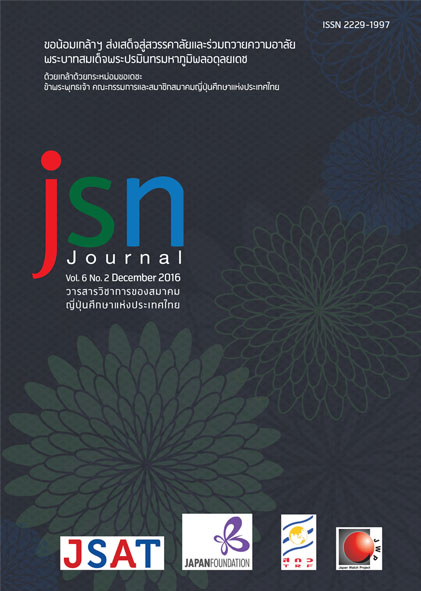Abenomics and Japanese State Transformation
Main Article Content
Abstract
“Abenomics,” the Abe administration’s economic policy announced in 2013, aims to revive Japan’s long stagnant economy. The policy consists of three “policy arrows” targeted at monetary policy reform, fiscal policy reform, and economic structural reform focused on deregulation. Scholars and policy makers have assessed the policy after implementation for sometime, and a number of assessments have focused on the success or failure of the policy impacts on economic stimulation, while the impacts went beyond economic growth. This article proposes that Abenomics has played apart in Japanese state transformation from a nation-state to a “market-state.” Its (Abenomics) overall impact is that the economic policies seem to prioritize the allocation of resources to the business sector rather than to labor.
Article Details
ข้อความและข้อคิดเห็นต่างๆ ในบทความเป็นของผู้เขียนบทความนั้นๆ ไม่ใช่ความเห็นของกองบรรณาธิการหรือของวารสาร jsn Journal
References
ไชยรัตน์ เจริญสินโอฬาร. (2550). ว่าด้วยความคิดทางการเมืองของฌาคส์ ร็องซีแยร์: การเมืองของสุนทรียศาสตร์/กวีนิพนธ์ของความรู้. กรุงเทพฯ: สมมติ.
เสกสรรค์ ประเสริฐกุล. (2553). การเมืองภาคประชาชนในระบอบประชาธิปไตยไทย. พิมพ์ครั้งที่ 3. กรุงเทพฯ: สำนักพิมพ์วิภาษา.
Anderson, Benedict. (2016). Imagined Communities: Reflections on the Origin and Spread of Nationalism. Revised Edition. London: Verso.
Bobbitt, Philip. (2003). The Shield of Achilles: War, Peace and the Course of History. London: Penguin Books.
Cabinet Decision, Government of Japan. (2013, January 1). Emergency Economic Measures for the Revitalization of the Japanese Economy. Retrieved from www5.cao.go.jp/keizai1/2013/130111_emergency_economic_measures.pdf.
Cabinet office. (2016, February 29). Achievements in Three Years of Abenomics. Retrieved from www5.cao.go.jp/keizai1/2016/achievements.pdf.
China GDP Annual Growth Rate 1989-2016. (2016, June). Trading Economics, Retrieved from http://www.tradingeconomics.com/china/gdp-growth-annual.
Council on Foreign Relations. (2016, February15). Abenomics and the Japanese Economy. CFR Backgrounders. Retrieved from http://www.cfr.org/japan/abenomics-japanese-economy/p30383.
Ezrati, Milton. (2015). Still Wallowing in the Shallows: The Ongoing Failure of Abenomics. The International Economic Policy, spring, 62-63, 94.
Hausman, K. Joshua & Wieland, F. Johannes. (2015, August). Abenomics: An Update. Retrieved from https://www.brookings.edu/wp-content/uploads/2016/07/ConferenceDraft_HausmanWieland_Abenomics.pdf
Inagaki, Kana. (2013, October 24). Loeb’s Third Point Cautious About Abenomics ‘Third Arrow’. Japan Real Time. Retrieved from http://blogs.wsj.com/japanrealtime/2013/10/24/loebs-third-point-cautious-about-abenomics-third-arrow/.
Iyoda, Mitsuhiko. (2010). Postwar Japanese Economy: Lessons of Economic Growth and the Bubble Economy. London: Springer.
Japan GDP Growth Rate 1980-2016. (2016, June).Trading Economics, Retrieved from http://www.tradingeconomics.com/japan/gdp-growth.
JILPT Statistical Information. (2016). Recent Statistical Survey Reports 2016. Retrieved from www.jil.go.jp/english/estatis/esaikin/esaikin.html.
Patrick, Hugh. (2014, October). Japan’s Abenomics: So Far So Good, But Will It Prevail? Retrieved from https://academiccommons.columbia.edu/download/fedora_content/download/ac:179143/CONTENT/OP_67.HP.Japan_s_Abenomics_-_So_Far_So_Good.Hugh_Patrick.pdf.
. (2016, January). Japan’s Abenomics Bumps Along. Retrieved from http://pifs.law.harvard.edu/wp-content/uploads/2015/10/Patrick-Japans-Abenomics-Bumps-Along.pdf.
Statistics Bureau. (2015). Summary of Average Results for 2015. In Annual Report on the Labour Force Survey 2015. Retrieved from http://www.stat.go.jp/english/data/roudou/report/2015/pdf/summary1.pdf.
Survey Shows High Rate of Overwork in Japan. (2016, May 18).The British Chamber of Commerce in Japan. Retrieved from https://www.bccjapan.com/news/2016/05/survey-shows-high-rate-overwork-japan/.
The Japan Institute for Labour Policy and Training. (2016). Labor Situation in Japan and Its Analysis: General Overview 2015/2016. Tokyo: The Japan Institute for Labour Policy and Training. Retrieved from http://www.jil.go.jp/english/lsj/general/2015-2016/2015-2016.pdf.
The Japan Times. (2016, June 19). In Fresh Shot at Elderly, Aso Asks: ‘How much longer do you intend to keep living? Retrieved from http://www.japantimes.co.jp/news/2016/06/19/ national/politics-diplomacy/fresh-shot-elderly-aso-asks-much-longer-intend-keep-living/#.WA-RY_mLS70.
Tsuneki, Atsushi & Matsunaka, Manabu. (2011). Labor Relations and Labor Law in Japan. Pacific Rim Law & Policy Journal, 20(3), 529-561. Retrieved from http://workspace.unpan.org/sites/internet/Documents/UNPAN93857.pdf.
Wakatabe, Masazumi. (2015). Japan’s Great Stagnation and Abenomics. New York: Palgrave.
Watanabe, Daisuke. (2016, February 5). How to Employ People in Japan — a Legal Perspective. Japan Industry News. Retrieved from https://www.japanindustrynews.com/2016/02/employ-people-japan-legal-perspective/.
Watanabe, Hiroaki R. (2015). Neoliberalism Reform for Greater Competitiveness: Labour Market Deregulation in Japan and Italy. Industrial Relations Journal, 46(1), 54-76.


